A splendid land of shining lochs, ragged mountains, ancient castles and a right bloodthirsty long brawl of history, Scotland boasts some of the most gripping stretches of motorcycling tarmac in all Europe. So what if you might get all four weather seasons in one day? Having kicked about Spain, Germany, Hungary, Canada, the United States and even far-off Burma on assorted motorcycles, I still yearn for riding joys surrounded by Scotia’s misty glens. A care-free mindset, the throttle twisted back, sweet highland air in the nostrils, eyes feasting upon mile after mile of unspoiled grandeur…aye lads, ye canny beat Scotland.
North of busy Stirling, Aberdeen and Inverness lie inviting two-lane “A” and even quieter “B” roads that thread among rolling hills and sweet valleys like cobwebs, mostly uninhabited except for the odd lunatic sheep. Jaguar cars and top-marque bike manufacturers send models here for road testing, so challenging is the terrain.
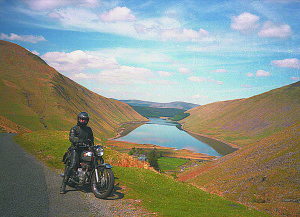
In his book The Land o’ Cakes and Brither Scots (1879), T. B. Johnstone wrote, “There is scarcely a corner of Scotland which does not contain some special feature of scenery, some river, mountain or glen which has not been the theme of the poet’s song, scene of some memorable struggle, or subject of eloquent and enthusiastic description.”
Scotland’s national hero William Wallace (Braveheart) first voiced the notion of selfless patriotism; French scientist Louis Pasteur observed Scotland was one of the first countries to ally its national destiny to the development of the human mind. Fellow Scotsman James Watt’s steam engine led us, in time, to the “motorcycle—a la the Michaux-Perreaux Steam Velocipede pioneered in France from 1868-71. Then there’s some long forgotten Scot’s discovery of Usequ Beatha—“water of life”—whisky. And we have great pubs!
BACK THEN
I first swung a leg over a bike, thrilling to the instant freedom and exhilaration of motorcycling, back when Scotland’s roads had no speed limits! “Ton-up” riding was the norm, and Glasgow’s “fast men” rode BSA DBD34 500cc Gold Stars, Triumph twins or Norton Dommies, the best of the pack in those vanished but not so distant times.
As we cleared 30 mph city limits, gearshifts down-clicked twice, throttles eased wide-open and big-mouthed Amal GP carburetors gulped hungrily for air. Throbbing exhausts echoed off dry stone walls while neatly executed speed-shifts transformed rural moorlands into eye-watering blurs.
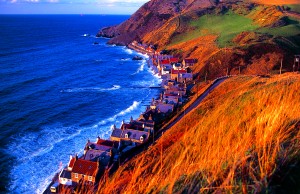
Glaswegian John Gallacher, astride his sexy silver 1955 Norton Dominator, was the fastest man on Loch Lomond-side roads. A national newspaper said so, chiding him for his carefree devil-be-damned spirit. That Dommie’s legendary Featherbed frame could hold any corner, its finely tuned 500cc engine awesome to hear, and John’s expert riding skills were a delight to observe…from behind!
Dawdling Sunday drivers in staid motorcars were overtaken at full bore, five or six at a clip. Adrenaline peaked following that spectral Norton into hairpin left and right handers. As for frightening Z-bends, something or other always dragged in a slipstream of golden sparks. Last man to the pub buying the round, I was always broke!
Most weekends we “road tested” some truly marvelous machinery. Vincents, BSAs, Sunbeams, Triumph Tiger 110s, Thunderbirds with sprung rear hubs, big single-jug Model 100 Panthers dragging sporty Steib S500 sidecars. Even the ultra-fast 750cc (bored out to 780cc) Triton CafÈ Racer with clip-on bars, alloy rims and close-ratio gearbox was among mouth-watering, if temporary, delights eagerly borrowed from trusting employer Bell Brother’s Motorcycles Ltd., (Glasgow) for whom John and I then worked.
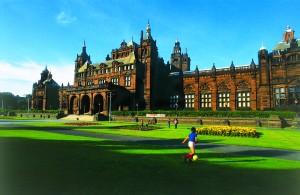
GLASGOW TO LOCH LOMOND
While today’s paltry 70-mph speed limits render Scottish motorways a little boring, and police speed cameras with ticket-issuing lenses spy on some roads, you can still enjoy reasonable speeds, if that’s your thing. But why race through such pastoral splendors? All you do is get from place to place, seeing nothing.
It’s a good idea to keep a close eye on your bike and gear when visiting Glasgow. It may get pinched. Do see the fine exhibit of interesting motorcycles at the Glasgow Transport Museum (free), and the Glasgow Art Gallery and Museum (also free) next door for Egyptian mummies, Jurassic jawbones, pious paintings and organ concerts. Snack on museum cafÈ scones and coffee before nosing your bike off into the nearby wilds.
Smooth, grippy, winding through gentle beauty, the Stockiemuir Road (A81) just a few miles outside Glasgow offers tons of fun, sweeping bends, sudden jumps and very short straights. Enjoy short detours to little known ruins like Mugdok Castle (B821) and grand views of the dreamy Campsie Hills. Then head back toward Drymen on A81, where you may be greeted by the colorful kilted pipes and drums band skirling rousing tunes of glory on the little village green.
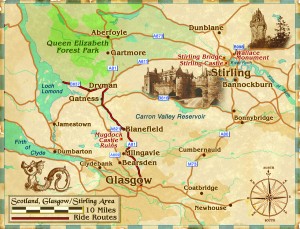
Drymen’s favorite rider’s lunch stop is the Clachan Inn, oldest in the land, former carousing haunt of freebooter Rob Roy, and more recently of irreverent comedian/actor Billy Connolly. From Drymen the B837, rugged and full of blind summits, sweeps northwest to dead end on the bonnie banks of Loch Lomond. Lined with countless woodsy places en route to pull bikes over, seductive poplars and oaks fret the shoreline. A nudist camp on an island here—like the Loch Ness Monster—has yet to be seen by anyone I know! At the end of the road lies the Rob Roy Inn. Do try their sumptuous homemade haggis with mashed turnips and new potatoes.
BRAVEHEART COUNTRY
Stirling, ancient gateway to the Highlands, simply reeks with history. Mel Gibson’s epic movie Braveheart has done more for the Scottish Tourist Board than anyone could have dreamed. Visiting pilgrims arrive eager to explore where all this bloody 13th-century melee took place. They mob Stirling Castle, nearby Bannockburn battlefield, and the stark 11th century tower of Cambuskenneth Abbey, where Wallace stored his military supplies.
Propping our motorcycles against ancient moss-covered walls we gazed over serpentine windings of the River Forth where, in 1297, Wallace crushed an invading English army at the Battle of Stirling Bridge. An enchanting 14th century pedestrian bridge still spans the site where slow-moving muddy swirls tumble, as if in mourning for that long ago hellish bloodshed.
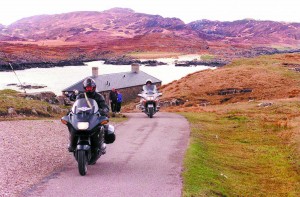
Off to the north stands the 220-foot-tall Wallace Monument, a gothic tower built in 1869. It marks the craggy volcanic summit from which Wallace, barely out of his teens, directed his troops. Atop the monument patriotic townsfolk get married, even hold windswept christenings while praying the terror-stricken infant isn’t blown over the parapets!
A couple of miles off the B998 is a rarely visited medieval graveyard crammed with curious 15th and 16th century moss-covered tombstones. Some are adorned with bold skulls and crossbones and are said to be witches graves. A ruined roofless church (1684) stands godly guard over the burials. Nearby a lovely ride up the tiny single-track road to the Sheriff Muir leads to a lonesome inn, happy to welcome motorcyclists for goodly dining or a friendly pint and some grand conversation with other riders.
Farther north there’s Scotland’s real-life brigadoon village, Crovie, pronounced Crivie, an hour or so north of Aberdeen. After negotiating the city’s nightmare of endless roundabouts, take the A947 through Oldmeldrum, Fyvie and Turrif and head for the old fishing town of Macduff. The best fish and chips in Scotland are found here, among the mighty wooden trawlers being built along the foreshore.
Head east on the B903 about 10 miles. Keep your speed down and eyes up or you’ll miss the minuscule wooden CROVIE sign. Follow the wee road that plummets 700 feet over red cliffs, then corkscrews 2nd gear-style down to the shimmering parking area.
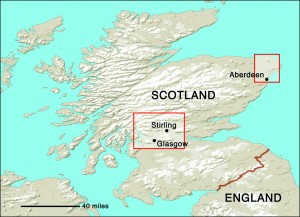
Crovie was a busy fishing village during the 17th century, employing 100 men and boys. Today its single line of 50 or so sturdy cottages with thick stone walls cower beneath the cliff fronted by a crumbling stone pier. Residents must trundle their goods from the parking lot using a communal wheelbarrow, so narrow is the raised cobblestone path between the waves and front doors. “You look down their chimneys before you look them in the face,” explains local artist Bill Russell of this unique little haven.
Next cove over lies Pennan, another enchanting village and location for much of Burt Lancaster’s movie Local Hero. The diminutive Pennan Hotel and tiny wharf, both featured in the movie, are each worth a visit. Try a warming plate of Cullen Skink, a local fish soup, hearty and tasty.
Whether you opt to ship your own trusty steed over the Atlantic or hire a bike from local rental outfits (see sidebar), you will never forget the delights of riding among Scotland’s unspoiled splendors. Best time to go is April through October.
(This article A Glimpse of Scottland: Motorcycling Adventure in Braveheart Country was published in the January 2004 issue of Rider magazine.)







